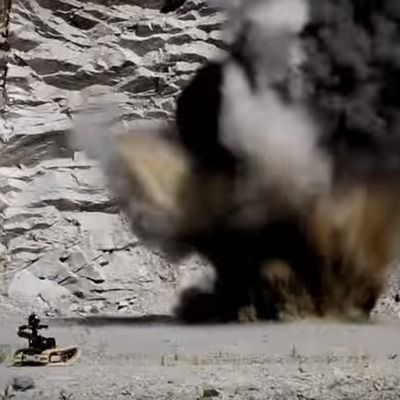I am in favor of responsible development of new technologies but, as always, it is a double-edged sword.
Scientists say smarter autonomous robots are dangerous and may start new era in warfare.
I am in favor of responsible development of new technologies but, as always, it is a double-edged sword.
Scientists say smarter autonomous robots are dangerous and may start new era in warfare.

A neural interface being created by the United States military aims to greatly improve the resolution and connection speed between biological and non-biological matter.
The Defence Advanced Research Projects Agency (DARPA) — a branch of the U.S. military — has announced a new research and development program known as Neural Engineering System Design (NESD). This aims to create a fully implantable neural interface able to provide unprecedented signal resolution and data-transfer bandwidth between the human brain and the digital world.
It’s not a fighter jet, it’s a Warthog (A-10), obviously.
Assuming this footage is real, that probably means it’s some kind of experimental ground attack drone. Also, I’ve read that there have been a few warthogs converted into drones themselves, so maybe it’s some sort of drone integration trials or something.
Or it’s aliens.
wink
Excited UFO hunters claim to have spotted fighter jets chasing an ‘alien ship’ — but then deciding not to shoot.
Naturally, the seasoned alien-spotters at UFO Sightings Daily claim this is proof that Earth’s military know not to mess with alien craft.
The incident, at Nova Zagora in Bulgaria, was shared by local site Portal12 — and shows a series of stills captured over the villages of Gaz and Zagortci.

The US Military’s experimental research division DARPA have confirmed that they’re to begin work on the world’s first human computer interface. This would effectively allow soldier ‘cyborgs’ to connect directly to computers and ‘talk’ to them.

I see this competition now between the US vs Russia/China in robotics as a good thing. For one it will make the silly campaigns against robots go away, as this will now become a matter of national security to advance robotics. And, secondly, it will force the government to put up a huge amount of money into robotics research even if they didnt really want to; the old guys think robots are silly. What that means for us in the general public is that we will get robot caregivers much sooner than we thought thanks to all this defense spending on robotics.
U.S. officials have ordered an investigation into whether China might be gaining an unfair competitive advantage in the robotics race.

It’s been a weird day for weird science. Not long after researchers claimed victory in performing a head transplant on a monkey, the US military’s blue-sky R&D agency announced a completely insane plan to build a chip that would enable the human brain to communicate directly with computers. What is this weird, surreal future?
It’s all real, believe it or not. Or at least DARPA desperately wants it to be. The first wireless brain-to-computer interface actually popped up a few years ago, and DARPA’s worked on various brain chip projects over the years. But there are shortcomings to existing technology: According to today’s announcement, current brain-computer interfaces are akin to “two supercomputers trying to talk to each other using an old 300-baud modem.” They just aren’t fast enough for truly transformative neurological applications, like restoring vision to a blind person. This would ostensibly involve connect a camera that can transmit visual information directly to the brain, and the implant would translate the data into neural language.
To accomplish this magnificent feat, DARPA is launching a new program called Neural Engineering System Design (NESD) that stands to squeeze some characteristically bonkers innovation out of the science community. In a press release, the agency describes what’s undoubtedly the closest thing to a Johnny Mneumonic plot-line you’ve ever seen in real life. It reads:
I usually never post articles like this one; however, it does raise a question for me. Could both defense and homeland security needs in addressing risks, and other emergencies really propel us sooner than later into singularity in order to ensure citizens their own protection. As other country militaries race to improve their own military AI & robotic capabilities. https://lnkd.in/ebMQ3Ab
If you thought Enhanced Human Operations (EHO) were an extravagant fantasy of Hollywood films and video games, then think again. Russia and China are involved in EHO, the act of modifying the brain and body in order to create “super soldiers” who will have the upper hand in battles.
Understandably, the United States is concerned about the prospect of having to join Russia and China by going down the Enhanced Human Operations route.
In a recent press conference, Bob Work, US Deputy Defense Secretary, warned that the US could be at risk of losing its “military competitive edge” if it fails to pursue military technology involved artificial intelligence.
Very true point & question to raise.
It’s been more than 60 years since the US successfully tested the first hydrogen bomb. Since then only four other countries—Russia, France, China, and the UK—have been able to make one themselves. This week North Korea claimed it had, but you can disregard Kim Jong-un’s boast for now.
A few more countries—India, Pakistan, South Africa, Israel, as well as North Korea—have the know-how to build simpler forms of nuclear weapons: atomic bombs. Still, no other technology in the world has remained out of the hands of so many countries for such a long time. Why?
It may be that the Cold War between the US and Russia deterred states from picking a battle with one of the big guns—but that didn’t stop India and Pakistan. Maybe the non-proliferation lobby after the Cold War convinced states that they don’t need nuclear weapons (South Africa, indeed, gave up its arsenal in 1991)—but Iran and North Korea kept trying.

Military Robots are full speed ahead.
Forget debates about Britain’s nuclear deterrent. New technology means a country can be brought to its knees with the click of a mouse.

Davos, US military branches, Time Magazine, etc. are all talking about the Robotic Battlefield.
Automated systems have already reshaped modern warfare, most notably with the widespread use of drones in conflict. Now, experts predict that advances in artificial intelligence could further change how we fight battles.
The new frontiers of warfare are not without ethical questions. Many have already challenged whether the United States should use unmanned drones to kill terrorists.
In this poll ahead of the World Economic Forum in Davos, TIME asks key questions about how readers think artificial intelligence will change warfare. TIME Executive Editor Michael Duffy will present the results in Davos, Switzerland on Jan. 21.